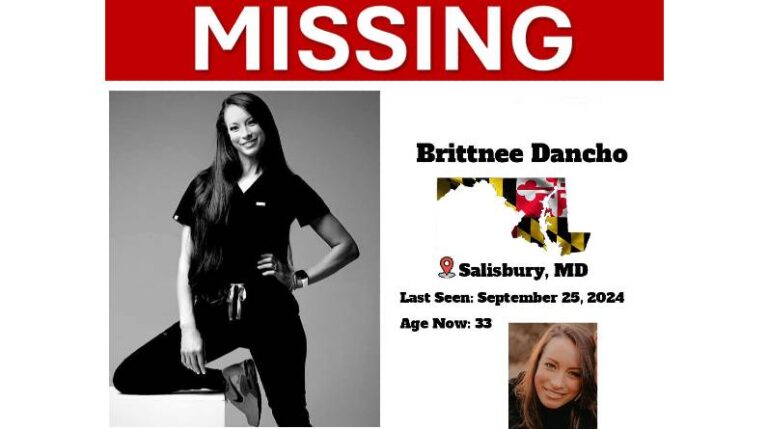Introduction
The mysterious disappearance of Brittnee Dancho in Maryland has left a lingering sense of unease, curiosity, and heartbreak. While she was eventually found alive, the case highlights significant gaps in how missing persons reports are handled and disseminated in the digital age. This article goes beyond the headlines to explore a new dimension: the role of misinformation, social media virality, and gaps in official communication during critical search hours.
Who is Brittnee Dancho?
Brittnee Dancho, a woman in her early thirties (some reports list her age as 27, others as 33), is a mother of three and an active member of her Salisbury, Maryland community. Known for her kind personality and love for art and music, Dancho’s sudden disappearance on September 25, 2024, shocked friends, family, and followers across various social media platforms.
Timeline of Events
| Date | Event |
| Sept 25, 2024 | Dancho reportedly disappears from Salisbury, MD |
| Sept 29, 2024 | “Missing People in America” announces she is found |
| Oct 1, 2024 | Maryland State Police confirm she was located in Virginia |
A Note Raises Alarm
A handwritten note, allegedly from Dancho, surfaced online, saying: “Please tell them I love them. Fed cat + dog. Love you all.” Although never officially validated by police, the note went viral and intensified public concern.
The Role of Social Media: A Double-Edged Sword
Benefits
- Rapid Awareness: Within hours, posts about Dancho’s disappearance reached tens of thousands on platforms like Facebook, X (formerly Twitter), and YouTube.
- Community Mobilization: Volunteer-led search parties were organized within days.
Drawbacks
- Unverified Claims: The most circulated flyer was not from law enforcement.
- Conflicting Information: Age discrepancies, uncorroborated notes, and duplicate posts created confusion.
“The Maryland Department of State Police did not issue any flyers or press releases for this case,” said an official spokesperson.
A Gap in Official Channels
One startling insight from this case is the absence of any public law enforcement-generated communication during Dancho’s disappearance. Instead, independent organizations and citizen sleuths took the lead. This creates a trust vacuum, where:
- Information is decentralized
- Rumors can spread unchecked
- Emotional stress increases for families
Case Comparison Table
| Case | Official Alert Issued? | Found Alive? | Social Media Impact |
| Brittnee Dancho | No | Yes | High |
| Gabby Petito | Yes (FBI) | No | Very High |
| Lauren Spierer | No | No | Moderate |
The Importance of Coordination in Missing Persons Cases
In missing person cases, especially those involving adults, coordination between:
- Law enforcement
- Non-profits
- Online communities
- Media outlets
…is critical to avoid misinformation and panic. Dancho’s case shows how non-official channels can fill a gap, but also raises ethical questions about accuracy and responsibility.
Psychological Impact on Families and Communities
Even though Dancho was eventually found safe, the emotional toll on those close to her cannot be underestimated.
Key Emotional Stressors:
- Lack of official updates
- Media speculation
- Social media pressure
- Fear of worst-case scenarios
Community vigils, shared prayers, and grassroots movements speak to how these incidents can galvanize—and sometimes traumatize—entire neighborhoods.
Lessons Learned and Future Precautions
For Law Enforcement
- Develop rapid-response digital flyers verified by department seal
- Collaborate with popular missing persons platforms
For Media
- Always verify the origin of flyers and quotes
- Be cautious in framing the disappearance (e.g., avoid assuming criminality or mental health issues prematurely)
For the Public
- Share responsibly
- Avoid amplifying rumors
- Report tips to official hotlines, not just social media pages
Unique Angle: The Case for a Unified National Platform
What if Brittnee Dancho’s case had been centralized in a verified national missing persons app, one that law enforcement and citizens both trust? The confusion around her age, note, and disappearance timeline underscores the need for a digitally unified alert system.
Proposed Platform Features
- Law enforcement dashboard
- AI verification of flyers and claims
- GPS heatmap of last known sightings
- Community search coordination tools
Such a tool could bridge the gap between official agencies and well-meaning civilians, ensuring that truth spreads faster than rumors.
Conclusion
Brittnee Dancho’s disappearance and safe recovery raise crucial questions about how missing persons cases are handled in today’s connected world. While social media was instrumental in spreading awareness, the lack of official updates reveals systemic weaknesses. As society moves further into the digital age, we must ensure that our tools, processes, and communities are equipped not just to react—but to respond wisely, accurately, and compassionately.
Frequently Asked Questions (FAQs)
Q: Was Brittnee Dancho really missing or was it a hoax?
A: Authorities confirmed she was reported missing and later found in Virginia. There is no evidence suggesting a hoax, though details remain private.
Q: Why didn’t police issue an official alert or flyer?
A: According to the Maryland State Police, they were not involved in distributing any public notices. Reasons for this remain unclear.
Q: Who found Brittnee Dancho?
A: Missing People in America, an independent nonprofit, reported her being found on Sept 29. Police later confirmed her recovery.
Q: Is her case still under investigation?
A: No, Maryland State Police have stated the case is now closed.
Q: What can the public do in similar situations?
A: Share verified information, avoid spreading rumors, and support affected families through community and emotional aid.


